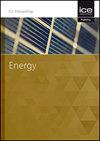优化电力系统扩展计划时纳入外部性:越南案例研究
IF 1
4区 工程技术
Q4 ENERGY & FUELS
Proceedings of the Institution of Civil Engineers-Energy
Pub Date : 2023-11-09
DOI:10.1680/jener.22.00066
引用次数: 0
摘要
传统上,电力系统扩容规划分两个阶段进行:优化未来发电系统以满足预测需求,其次是优化互补输电系统。然而,现在在计算上可以同时优化这两个方面,即使对于大型复杂的系统也是如此。同时,要考虑的候选发电厂类型的范围已大大扩大,现在必须将风能、太阳能和生物质能发电厂的技术和经济特性与传统的热电厂和水力发电厂进行比较。在规划过程中明确考虑到所谓的“外部因素”,例如排放限制、预算限制和需求管理措施,以及与个别项目有关的环境成本和次要利益,也变得越来越重要。本文描述了一项研究的结果,以证明在数学上优化发电和输电系统扩展计划时明确考虑一系列外部性的可行性,并以越南电力系统为例。本文章由计算机程序翻译,如有差异,请以英文原文为准。
Incorporating externalities when optimising power system expansion plans: a case study for Vietnam
Power system expansion planning has traditionally been conducted in two phases: optimisation of the future generation system to satisfy forecast demands, followed by that of a complementary transmission system. However, it is now computationally realistic to optimise both aspects simultaneously, even for large and complex systems. At the same time, the range of candidate generation plant types to be considered has widened considerably, with the technical and economic characteristics of wind, solar and biomass plants now having to be compared with those of conventional thermal and hydro plants. It is also becoming increasingly important to take explicit account, within the planning process, of the so-called ‘externalities’ such as emission limits, budget constraints and demand-management measures, in addition to the environmental costs and secondary benefits associated with individual projects. This paper describes the results of a study to demonstrate the feasibility of explicitly considering a range of externalities when mathematically optimising integrated generation and transmission system expansion plans, using the Vietnamese power system as an example.
求助全文
通过发布文献求助,成功后即可免费获取论文全文。
去求助
来源期刊

Proceedings of the Institution of Civil Engineers-Energy
ENERGY & FUELS-
CiteScore
3.00
自引率
18.20%
发文量
35
期刊介绍:
Energy addresses the challenges of energy engineering in the 21st century. The journal publishes groundbreaking papers on energy provision by leading figures in industry and academia and provides a unique forum for discussion on everything from underground coal gasification to the practical implications of biofuels. The journal is a key resource for engineers and researchers working to meet the challenges of energy engineering. Topics addressed include: development of sustainable energy policy, energy efficiency in buildings, infrastructure and transport systems, renewable energy sources, operation and decommissioning of projects, and energy conservation.
 求助内容:
求助内容: 应助结果提醒方式:
应助结果提醒方式:


